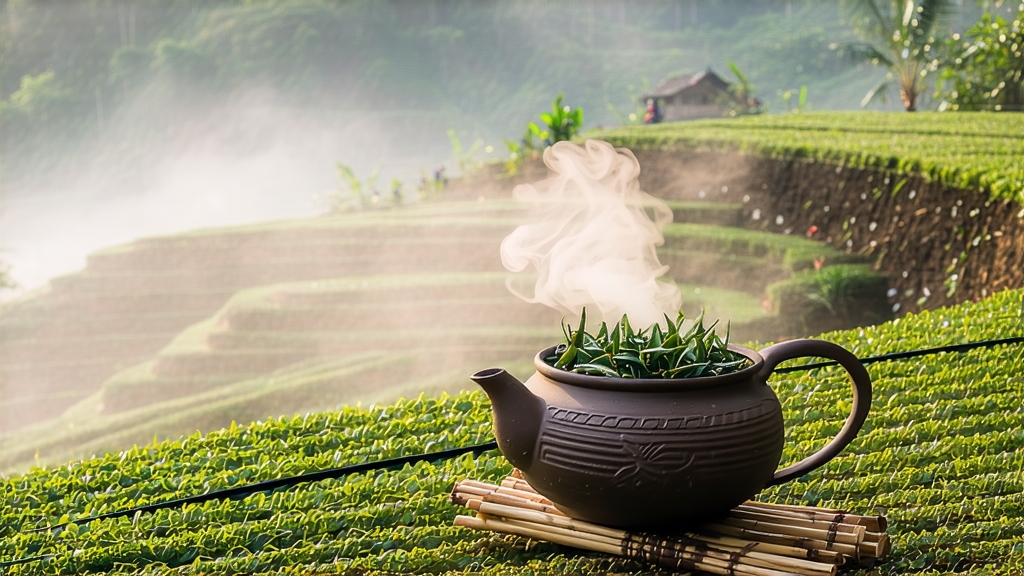
Tucked away in the humid, karst-pocked mountains of southern China’s Guangxi Zhuang Autonomous Region, Liupao (literally “Six Forts”) is the quietest celebrity of the dark-tea family. While Pu-erh hoards the global spotlight, Liupao has spent four centuries perfecting a deeper, duskier alchemy that once greased the wheels of the ancient Tea-Horse Road and still perfumes the cellars of Hong Kong tea merchants. To understand Liupao is to listen to a slow bass note in China’s tea symphony—low, resonant, and insistently earthy.
Historical echoes
The first written record appears in the 1620 Wanli-era county gazetteer of Cangwu: “Dark leaves from the Six Stockades, pressed into baskets, traded for salt.” Those stockades—Liupao, Da’an, Gang’ao, Ying’ao, Siping and Hezhou—gave the tea its name and its first market. By the Qing dynasty the tea had migrated southward with coolie laborers, becoming the morning staple of dockworkers in Guangzhou and the secret ingredient in Hong Kong’s “mother’s milk” milk-tea. British planters in colonial Malaya even tried to replicate it in the 1930s, failing because they could not transplant the microscopic flora clinging to Guangxi’s bamboo baskets.
Terroir and leaf
Liupao is born between the 23rd and 24th parallels where the Tropic of Cancer licks the region with 1,600 mm of rain and a fog-draped 80 % humidity. The indigenous large-leaf variety, Camellia sinensis var. assamica cv. Guangxi, develops leaves as broad as a farmer’s palm, thick enough to survive two separate fermentations. The best gardens sit at 300–500 m on lateritic red soil laced with quartz; locals swear the iron-rich earth gives Liupao its signature “betel-nose” aroma—sweet, resinous, faintly medicinal.
Crafting darkness: a two-act play
Harvest begins in late April, when three leaves and a bud still wear spring’s downy coat. After a brief outdoor withering the leaves are yanked into a 200 °C wok for five minutes of shaqing—kill-green—hot enough to blister thumbs but brief enough to keep enzymes alive. While still warm they are rolled into tight cords, breaking cell walls for future microbial banquets.
Act I is wet-piling, unique among dark teas for its restrained scale. Leaves are stacked 70 cm high inside bamboo steamers lined with fresh banana leaves. A mist of mountain water raises moisture to 30 % and the pile is covered with jute sacks. Over the next 25 days the internal temperature climbs to 55 °C; thermophilic Aspergillus niger and Bacillus subtilis bloom, oxidizing catechins into theaflavins and thearubigins. Every three days the pile is turned by barefoot workers who judge readiness by aroma: the sharp green note must retreat, replaced by the scent of damp forest floor after rain.
Act II is basket aging. The fermented maocha is steamed again, stuffed into 40 kg bamboo cylinders lined with untreated sugarcane paper, and pressed with a wooden lever until the leaves squeak. The baskets are then slid into ventilated cellars built into hillsides where humidity hovers at 85 % and temperature swings gently between 20 °C and 28 °C. Here a second microbial community—dominated by Eurotium cristatum, the same “golden flower” prized in Hunan Fu brick—colonizes the leaf, weaving a faint yellow dust across the surface. Minimum legal aging is 180 days, yet connoisseurs chase vintages of 1983, 1996, or 2005 when subtropical storms forced longer indoor resting, deepening the liquor to espresso black.
Grades and shapes
Unlike Pu-erh’s cake obsession, Liupao remains a basket tea. Officially it is graded from Superfine (tippy, ≤ 1 cm cut) down to Grade 4 (broad, 3 cm cut). A parallel folk taxonomy speaks of “Song” (loose), “Lang” (tight basket), and “Gui” (turtle-shell brick pressed from basket overflow). Each shape ages differently: loose leaf breathes fastest, reaching peak mellow in eight years; tight baskets need fifteen; turtle bricks, protected by higher compression, can still evolve after three decades.
The art